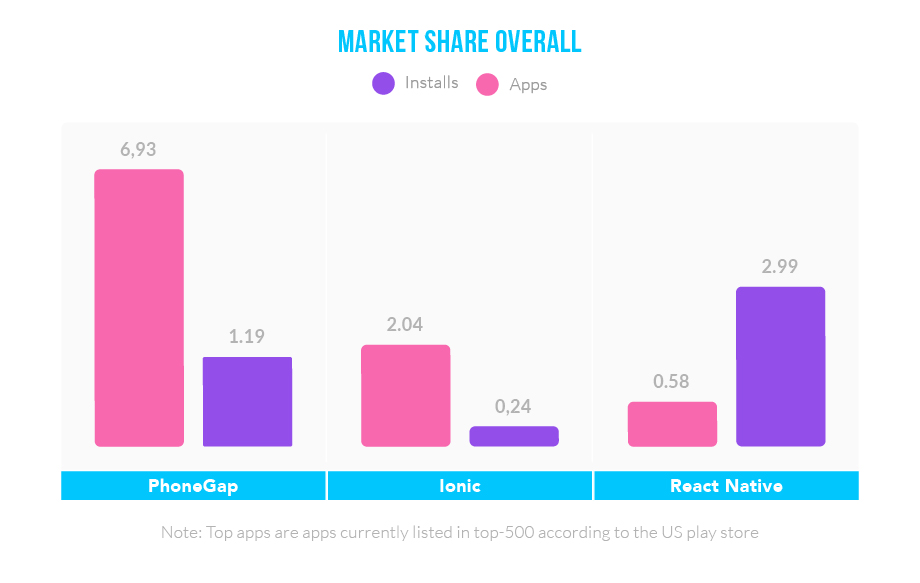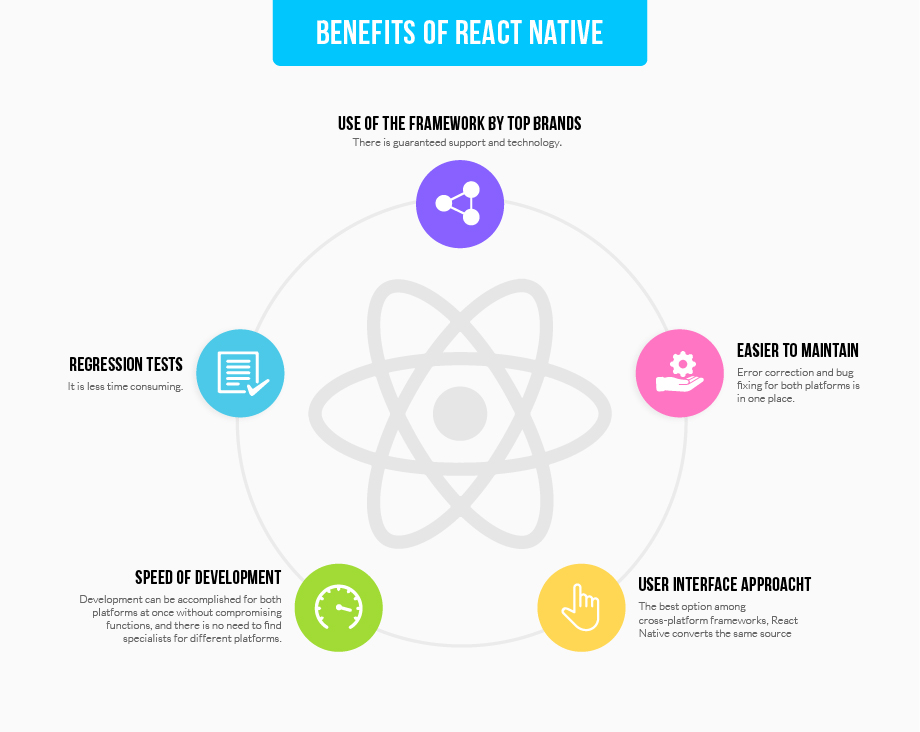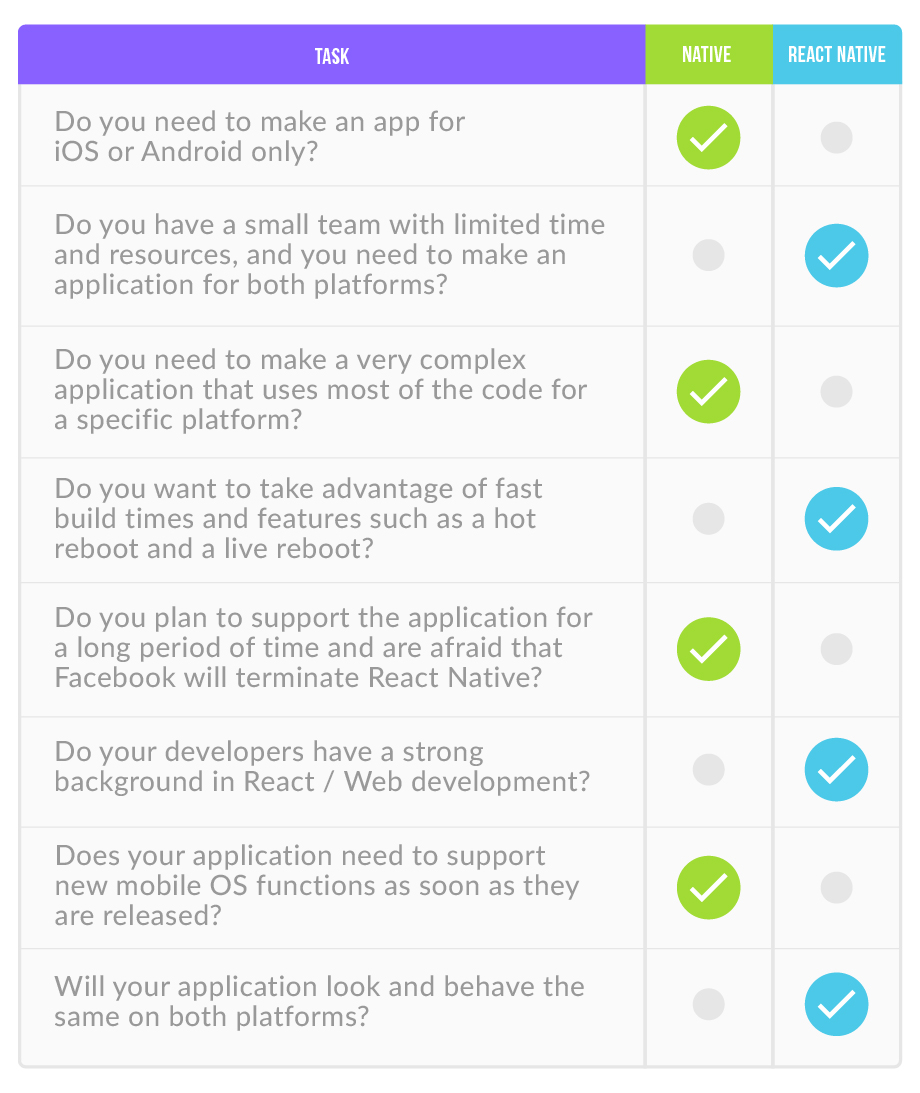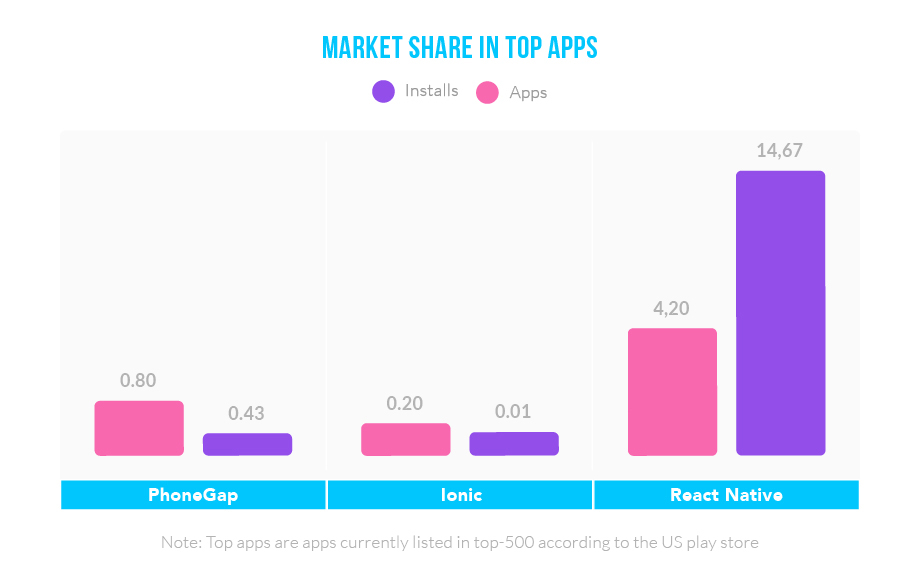By: Evgeniya Vi.
28 JAN 2019
3490
How does React Native differ from native mobile application development? Why React Native developers are becoming more popular, and what kind of specialist (native or cross-platform developer) should you choose for your project? Let’s check this out.
Having one structure that will cover all platforms has been a dream of the industry for many years.
For example, with regard to web development, you access most of the functions on your laptop using just one application: a web browser. No one asks what was used to create it (HTML5, CSS, or JS) since there is a certain standard.
Mobile development, however, went in a completely different direction. Fifteen years ago, no one knew how to create an interface in mobile applications. We probably all remember how Symbian looked and how iOS and Android differed from each other at the very beginning. At that time, it was very difficult to prepare one framework that would somehow be useful on all platforms. Of course, Xamarin, PhoneGap and many others all did their best to achieve this goal, but none of the end products were very good.
Today everything is changing, especially when it comes to the user interface. The efficiency of devices has increased, and market fragmentation has decreased. Now there are just two players: Android and iOS. A few years ago, it was necessary to create applications not only for iOS and Android but also for Windows Phone, Symbian/Java, and Blackberry.
React Native is the first structure that allows us to create a mobile application that will work on both iOS and Android without needing to compromise on speed, efficiency, and overall appearance. But one thing will never change: You will need the right development partner because, in the end, the appearance of the React Native application depends on the developer.
So let’s see what React Native is all about and whether this particular framework is the right technology for your project.
React Native - the new opportunity for cross-platform developers
React Native is a framework created by Facebook to ensure smooth and simple cross-platform mobile development. This basically means that you do not need to create separate applications for iOS and Android.
React Native allows you to develop your own mobile apps for iOS and Android using the same JavaScript codebase.
React Native was announced at the React.js conference on Facebook in February 2015 and became available in March 2015.
Today, this framework is gaining more and more market share. AppBrain data confirms this:
The number of popular mobile applications that use React Native is constantly growing. Instagram, Uber, Facebook, Pinterest, SoundCloud, Skype, Viber Messenger, Microsoft OneDrive, and Discord are just some of the popular applications that use React Native in whole or in part. Developers and owners of applications then have a logical question: Is it worth it to develop a native application at all if you can just use React Native? Naturally, to answer this question, you need to compare both development options. But before that, it is important to understand how React Native works.
React Native uses the React.js library. The difference between React and React Native is that the latter uses its own components instead of web components to create a user interface in addition to JSX, which is the syntax used to embed XML with JavaScript. This means that a developer writes code for a mobile application in much the same way as they do for a web application. We will not go into the nuances of writing components and coding in general, so let’s just say that the coding styles of web development and React Native are quite similar, and this framework’s sets of components are compared to the native analogues of iOS and Android.
All of this makes React Native easier to use than native development, and it is therefore faster and cheaper.
Despite the obvious advantages, the use of React Native is not always justified. If we compare native and Reactive Native development, we can better conclude what to choose for a specific project.
A comparison of Native and React Native development
React Native is a cross-platform development. We have already written about the difference between these two types of development, considered their advantages and disadvantages, and recommended what criteria to use when making a decision for a particular project. This also applies to React Native, with only one nuance. This framework has established itself as the best quality tool, and accordingly, applications created with its help function more efficiently and look as close as possible to the native framework.
Therefore, the choice between native and cross-platform development using React Native lies not so much in the quality but rather in the area of satisfaction with the project specifics.
Let’s look at a few basic criteria that will help form an understanding of how native development differs from cross-platform development using the React Native framework.
Programming language
React Native is based on React.js, which is written in JavaScript. On the one hand, this is an advantage as it is a fairly extensive, popular, and widely used language, and despite the fact that the React Native framework is fairly new, finding a qualified developer is quite simple, and the JS community is mature.
On the other hand, there is a problem with the fact that it is an untyped language in contrast to Swift / Objective-C and Java, which are strongly typed and compiled. This means that React Native does not have great control over variables, and the application logic is not as predictable as in native development. Here, everything is built on the experience of the programmer, automatic tests, and the Lint tools. Thus, the search for errors takes much longer, especially if the performer is not sufficiently qualified, as the compiler will not help in this case. As you know, time is money, so the cost of the application may increase.
Codebase
A single JavaScript code base for two different platforms allows you to maintain the same development process for both platforms and reuse the same code. This requires fewer resources because there is no need for separate iOS and Android commands.
However, this advantage is also associated with additional costs. It is well known that Android and iOS have different design principles. The UI Guide for iOS and Material Design for Android have many differences, so if the project stipulations dictate that these specific OS requirements must be met for each platform, the React Native developer will need to write platform-specific code that will achieve the goal of a single code base. This can be a big problem when it comes to iOS because Apple often updates and devalues its older technologies, which are difficult to monitor.
It should be noted that even taking into account the fact that you can allow the ability to write an application that looks the same on both platforms, it is still impossible to write an application without writing any code on the native platform. Some components look great on iOS and bad on Android and vice versa, which makes it necessary to fine-tune these specific cases. Nevertheless, even with a platform interface in the code, having even 30% of the total code base, big money and time are saved in the long term.
Hot reloading and Live reloading
React Native solves the problem of excessive time spent on assembly. This problem is especially acute in Xcode or Android Studio if, for example, you are working on a function that is located several screens away from the launch screen.
A hot reboot in React Native keeps the application running in its current state and introduces only those changes that are performed in the code. It is worth noting that this is not an ideal solution, but it is quite stable in most cases and saves a lot of time.
Real-time reloading can be used automatically when the code changes and eliminates the need for manual reloading, which is common in native development, and this also significantly speeds up the build time of the application.
Native modules
There will always be a need to use native modules. These are native language codes that handle certain functions. Examples of custom modules are camera modules, your own image picker, push notifications, deep bindings, and third-party services, such as Auth0 or Amplitude.
These modules must be linked to the link-native link command, but in most cases, this will not be enough. The developer will then need to follow certain instructions in order to link his or her own module so that it can work on both iOS and Android.
If React Native cannot process the code, then it can be written in its native language. There is a problem here however: If the developer has never worked with native languages, then it will be difficult for him or her to link the library. This will increase the overall development time.
There is also an issue with the publication of applications, especially iOS. To release an application, the React Native developer will, at the very least, need to use Xcode to customize release-related data, such as training profiles and certificates.
User interface
React Native’s user interface structuring approach is the Flexbox, which is already very popular in web development circles and allows the developer to easily create a customizable web interface or mobile interface. Thus, it is a technology that competes with the idea of XML / Constraint for Android or iOS / XIB / Coding storyboards with user interface libraries, such as the Neon approach.
One significant advantage that native development has is that you have access to all of your own APIs, such as a camera, touch ID, and GPS, as well as tools for creating animations and complex user interfaces. There is no middle level, and you can take advantage of everything that a mobile platform can offer. React Native has not yet succeeded in creating complex user interfaces and animations. It has an animated API, which is a clever solution, but it is still far below its own capabilities.
React Native redisplays a component by default every time its state changes. If you use it carefully and professionally, then this paradigm for creating a user interface is excellent. Otherwise, it can be a source of wastefully repetitive work. It should be noted that in a single-threaded JavaScript environment, performance problems may arise, and you should be careful when creating the user interface.
In addition, some complex mobile features are best done in native development. One example of this is Apple’s ARKit for creating an augmented reality experience. Another example is applications that are very platform specific, such as applications for watchOS or tvOS.
React Native does not offer a simple way of providing the power of the user interface, as the native language does, so for applications that require a very complex interface or complex animations, this is not the best choice. For simple applications, however, this is the best option due to the way Flexbox handles the flexible UI interface as well as the simple and intuitive structuring of XML components.
Testing
React Native loses in comparison with native development when it comes to the testing and debugging of the program through the search for and elimination of bugs.
Native development is part of a single ecosystem, and it eliminates the need to switch between different codes and includes built-in debugging tools. A large number of libraries are offered for React Native for this very purpose, but more attention and efforts will be required during the application testing process.
Native or cross-platform development with React Native: which one to choose
The React Native framework is becoming increasingly popular among developers and is increasingly in demand by customers.
It would seem obvious. React Native allows you to significantly reduce the cost of development without a significant loss in quality. In practice, development time is accelerated by 30–40%, and the high quality of the product is still directly related to the professionalism of the developers and the technical team.
But before deciding whether to choose a native or cross-platform development using React Native, Appus developers advise taking into account the nuances of your project. Here are our recommendations:
When to choose native (iOS or Android) development
We at Appus Studio recommend using native development if the functions of your project require a large amount of unique code for each of the platforms. If your application assumes the presence of complex widgets or is based on native frameworks, then choosing React Native is not advisable. In other words, if you want to get a high-quality application with modern features, such as AR / VR (you plan to use ARKit / ARCore); create an application for smart watches or use SiriKit or Spotlight; or you need accurate native GPS tracking, etc., native development is best, and it will come out better and be cheaper in the long run.
Clearly, if you are planning to develop an application only for iOS or only for Android, then you should not consider cross-platform development.
In addition, if you plan that your application will quickly adapt to changes in the OS of any of the platforms, then you should also stop at native development since in the case of React Native, it may take a long time for this framework to adapt to the changes.
The long-term perspective should not be discounted. How long do you think your application will last? Native languages will easily survive long term, but no one can predict how long React Native will exist.
When to choose cross-platform development using the React Native framework
You can save money on app development, but you should do so wisely. React Native is good in many situations and can often successfully replace native development. After all, we should not forget that this framework can be used even when the project involves the use of native modules for the implementation of specific functions. Working with React Native offers two options:
- Writing code in pure JS using Expo. In this case, the interlayer flexibility is lost, but this is an effective approach when working with complex graphics.
- Use of native modules. When using React Native, the entire visual part is already written, and if specific functions are needed, then the code is written for each platform individually.
There are also cases where using React Native is necessary.
For example, the framework is ideal for creating applications that provide data processing, such as textual information and tables. These operations do not require special approaches for each individual platform, and the development process does not take much time and does not cause problems.
Applications for travelers that offer search and booking, applications for retailers, blogs, chats—all of these are the types of products that, when created by React Native, can significantly reduce the amount of money, effort, and time spent.
For these reasons, Appus specialists recommend this framework if the application does not involve a large number of specific functions and you intend to cover several platforms in conjunction with a limited budget and timeframe—and, of course, when the use of React Native is more expedient in terms of price and quality.
In conclusion
Before you make a decision, pay attention to certain aspects of the development of this framework. These are just reflections on the future of React Native, but we also advise you to think about them the next time you are developing an app.
As mentioned above, the life cycle of React Native is not guaranteed, unlike the native languages that will be with us into the foreseeable future. However, the community of this cross-platform framework is rapidly growing and expanding.
Interestingly, the applications written on this framework account for 0.58% of the total market share of Android applications (according to AppBrain), and while using React Native, 4.2% of top-end applications were created, which is much higher than PhoneGap and Ionic.
Does this mean that the future is bright for React Native?
Remember that React Native was developed by Facebook, and there is a possibility that the creator may, at his discretion, eliminate the framework at any time, such as with the Parse service platform, which was closed in 2017.
At the moment, the framework is actively being updated, but there is seemingly no interest in correcting errors that are not directly related to the Facebook application. Because of this, you must either wait for Facebook to fix it or correct it yourself, which will increase the creation time.
In addition, there is always a time lag between the introduction of new functions on platforms and their introduction into React Native. By default, developing something using a new technology will always take longer.
Thus, we are now seeing positive trends in the development of this framework. It is still in development, and we have not seen its full potential.
In the future, it may be more effective and efficient and may provide even greater uses, but for now, it cannot completely replace native mobile development. All of this leads to a very important conclusion: React Native is much more effective if it is used by developers who already have experience in developing mobile applications using native languages since it does not completely eliminate the need to switch to the native language.
Whatever your choice of tool, both you and the development team should be assured of the functionality of the future application. The final result depends on the correct setting of goals and the subsequent correct selection of tools.
We are ready to provide you with a free consultation on the development of your project and to help you determine the optimal type of development that will be most effective for your project (in order to answer your question if you need a native or React Native developer).
Good luck with your project!
 Services
Services
 Work
Work
 Company
Company
 Blog
Blog
 Contact
Contact






